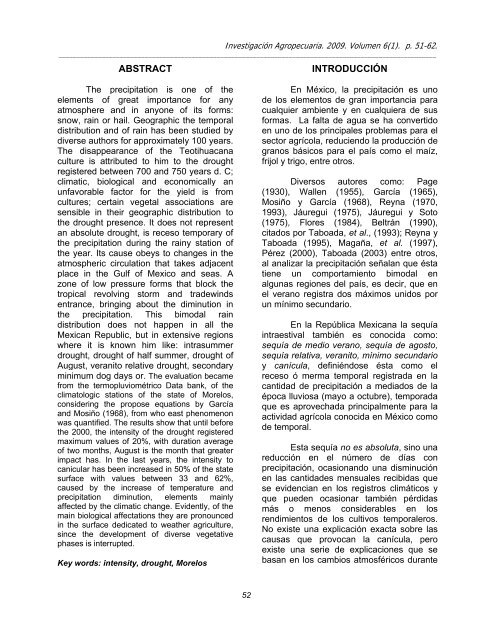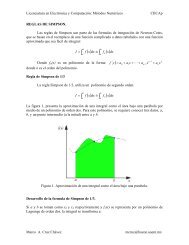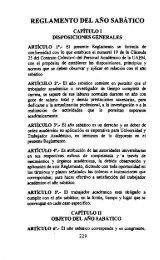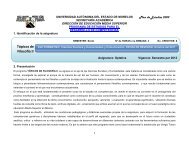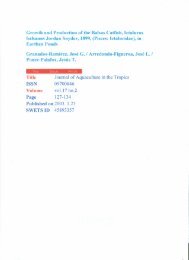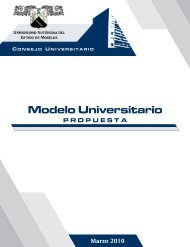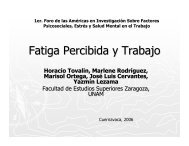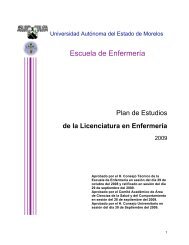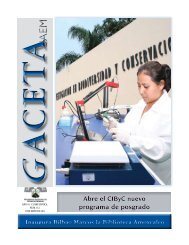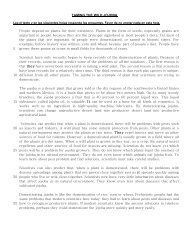Descargar - UAEM - Universidad Autónoma del Estado de Morelos
Descargar - UAEM - Universidad Autónoma del Estado de Morelos
Descargar - UAEM - Universidad Autónoma del Estado de Morelos
You also want an ePaper? Increase the reach of your titles
YUMPU automatically turns print PDFs into web optimized ePapers that Google loves.
Investigación Agropecuaria. 2009. Volumen 6(1). p. 51-62.<br />
_________________________________________________________________________________________________________<br />
ABSTRACT<br />
The precipitation is one of the<br />
elements of great importance for any<br />
atmosphere and in anyone of its forms:<br />
snow, rain or hail. Geographic the temporal<br />
distribution and of rain has been studied by<br />
diverse authors for approximately 100 years.<br />
The disappearance of the Teotihuacana<br />
culture is attributed to him to the drought<br />
registered between 700 and 750 years d. C;<br />
climatic, biological and economically an<br />
unfavorable factor for the yield is from<br />
cultures; certain vegetal associations are<br />
sensible in their geographic distribution to<br />
the drought presence. It does not represent<br />
an absolute drought, is receso temporary of<br />
the precipitation during the rainy station of<br />
the year. Its cause obeys to changes in the<br />
atmospheric circulation that takes adjacent<br />
place in the Gulf of Mexico and seas. A<br />
zone of low pressure forms that block the<br />
tropical revolving storm and tra<strong>de</strong>winds<br />
entrance, bringing about the diminution in<br />
the precipitation. This bimodal rain<br />
distribution does not happen in all the<br />
Mexican Republic, but in extensive regions<br />
where it is known him like: intrasummer<br />
drought, drought of half summer, drought of<br />
August, veranito relative drought, secondary<br />
minimum dog days or. The evaluation became<br />
from the termopluviométrico Data bank, of the<br />
climatologic stations of the state of <strong>Morelos</strong>,<br />
consi<strong>de</strong>ring the propose equations by García<br />
and Mosiño (1968), from who east phenomenon<br />
was quantified. The results show that until before<br />
the 2000, the intensity of the drought registered<br />
maximum values of 20%, with duration average<br />
of two months, August is the month that greater<br />
impact has. In the last years, the intensity to<br />
canicular has been increased in 50% of the state<br />
surface with values between 33 and 62%,<br />
caused by the increase of temperature and<br />
precipitation diminution, elements mainly<br />
affected by the climatic change. Evi<strong>de</strong>ntly, of the<br />
main biological affectations they are pronounced<br />
in the surface <strong>de</strong>dicated to weather agriculture,<br />
since the <strong>de</strong>velopment of diverse vegetative<br />
phases is interrupted.<br />
Key words: intensity, drought, <strong>Morelos</strong><br />
52<br />
INTRODUCCIÓN<br />
En México, la precipitación es uno<br />
<strong>de</strong> los elementos <strong>de</strong> gran importancia para<br />
cualquier ambiente y en cualquiera <strong>de</strong> sus<br />
formas. La falta <strong>de</strong> agua se ha convertido<br />
en uno <strong>de</strong> los principales problemas para el<br />
sector agrícola, reduciendo la producción <strong>de</strong><br />
granos básicos para el país como el maíz,<br />
frijol y trigo, entre otros.<br />
Diversos autores como: Page<br />
(1930), Wallen (1955), García (1965),<br />
Mosiño y García (1968), Reyna (1970,<br />
1993), Jáuregui (1975), Jáuregui y Soto<br />
(1975), Flores (1984), Beltrán (1990),<br />
citados por Taboada, et al., (1993); Reyna y<br />
Taboada (1995), Magaña, et al. (1997),<br />
Pérez (2000), Taboada (2003) entre otros,<br />
al analizar la precipitación señalan que ésta<br />
tiene un comportamiento bimodal en<br />
algunas regiones <strong><strong>de</strong>l</strong> país, es <strong>de</strong>cir, que en<br />
el verano registra dos máximos unidos por<br />
un mínimo secundario.<br />
En la República Mexicana la sequía<br />
intraestival también es conocida como:<br />
sequía <strong>de</strong> medio verano, sequía <strong>de</strong> agosto,<br />
sequía relativa, veranito, mínimo secundario<br />
y canícula, <strong>de</strong>finiéndose ésta como el<br />
receso ó merma temporal registrada en la<br />
cantidad <strong>de</strong> precipitación a mediados <strong>de</strong> la<br />
época lluviosa (mayo a octubre), temporada<br />
que es aprovechada principalmente para la<br />
actividad agrícola conocida en México como<br />
<strong>de</strong> temporal.<br />
Esta sequía no es absoluta, sino una<br />
reducción en el número <strong>de</strong> días con<br />
precipitación, ocasionando una disminución<br />
en las cantida<strong>de</strong>s mensuales recibidas que<br />
se evi<strong>de</strong>ncian en los registros climáticos y<br />
que pue<strong>de</strong>n ocasionar también pérdidas<br />
más o menos consi<strong>de</strong>rables en los<br />
rendimientos <strong>de</strong> los cultivos temporaleros.<br />
No existe una explicación exacta sobre las<br />
causas que provocan la canícula, pero<br />
existe una serie <strong>de</strong> explicaciones que se<br />
basan en los cambios atmosféricos durante


